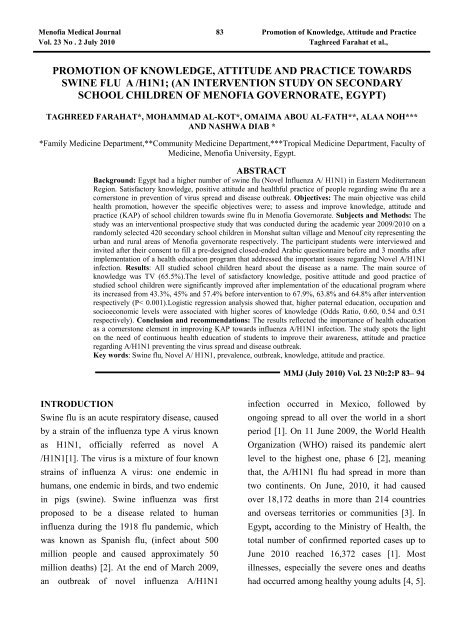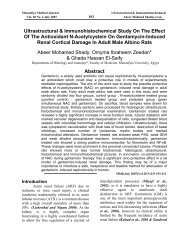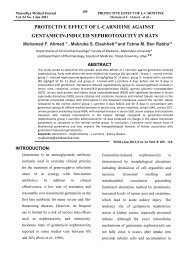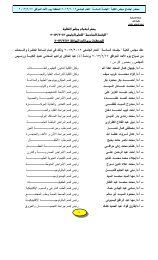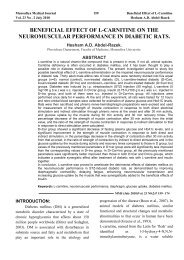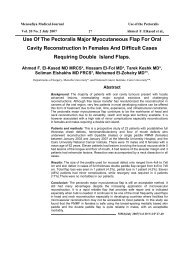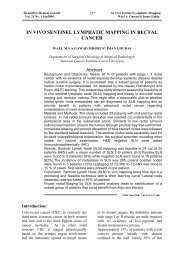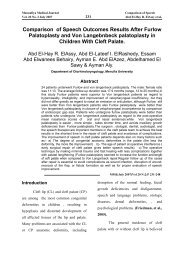promotion of knowledge, attitude and practice towards swine flu a ...
promotion of knowledge, attitude and practice towards swine flu a ...
promotion of knowledge, attitude and practice towards swine flu a ...
You also want an ePaper? Increase the reach of your titles
YUMPU automatically turns print PDFs into web optimized ePapers that Google loves.
Men<strong>of</strong>ia Medical Journal 83 Promotion <strong>of</strong> Knowledge, Attitude <strong>and</strong> PracticeVol. 23 No . 2 July 2010Taghreed Farahat et al.,PROMOTION OF KNOWLEDGE, ATTITUDE AND PRACTICE TOWARDSSWINE FLU A /H1N1; (AN INTERVENTION STUDY ON SECONDARYSCHOOL CHILDREN OF MENOFIA GOVERNORATE, EGYPT)TAGHREED FARAHAT*, MOHAMMAD AL-KOT*, OMAIMA ABOU AL-FATH**, ALAA NOH***AND NASHWA DIAB **Family Medicine Department,**Community Medicine Department,***Tropical Medicine Department, Faculty <strong>of</strong>Medicine, Men<strong>of</strong>ia University, Egypt.ABSTRACTBackground: Egypt had a higher number <strong>of</strong> <strong>swine</strong> <strong>flu</strong> (Novel In<strong>flu</strong>enza A/ H1N1) in Eastern MediterraneanRegion. Satisfactory <strong>knowledge</strong>, positive <strong>attitude</strong> <strong>and</strong> healthful <strong>practice</strong> <strong>of</strong> people regarding <strong>swine</strong> <strong>flu</strong> are acornerstone in prevention <strong>of</strong> virus spread <strong>and</strong> disease outbreak. Objectives: The main objective was childhealth <strong>promotion</strong>, however the specific objectives were; to assess <strong>and</strong> improve <strong>knowledge</strong>, <strong>attitude</strong> <strong>and</strong><strong>practice</strong> (KAP) <strong>of</strong> school children <strong>towards</strong> <strong>swine</strong> <strong>flu</strong> in Men<strong>of</strong>ia Governorate. Subjects <strong>and</strong> Methods: Thestudy was an interventional prospective study that was conducted during the academic year 2009/2010 on ar<strong>and</strong>omly selected 420 secondary school children in Monshat sultan village <strong>and</strong> Menouf city representing theurban <strong>and</strong> rural areas <strong>of</strong> Men<strong>of</strong>ia governorate respectively. The participant students were interviewed <strong>and</strong>invited after their consent to fill a pre-designed closed-ended Arabic questionnaire before <strong>and</strong> 3 months afterimplementation <strong>of</strong> a health education program that addressed the important issues regarding Novel A/H1N1infection. Results: All studied school children heard about the disease as a name. The main source <strong>of</strong><strong>knowledge</strong> was TV (65.5%).The level <strong>of</strong> satisfactory <strong>knowledge</strong>, positive <strong>attitude</strong> <strong>and</strong> good <strong>practice</strong> <strong>of</strong>studied school children were significantly improved after implementation <strong>of</strong> the educational program whereits increased from 43.3%, 45% <strong>and</strong> 57.4% before intervention to 67.9%, 63.8% <strong>and</strong> 64.8% after interventionrespectively (P< 0.001).Logistic regression analysis showed that, higher paternal education, occupation <strong>and</strong>socioeconomic levels were associated with higher scores <strong>of</strong> <strong>knowledge</strong> (Odds Ratio, 0.60, 0.54 <strong>and</strong> 0.51respectively). Conclusion <strong>and</strong> recommendations: The results reflected the importance <strong>of</strong> health educationas a cornerstone element in improving KAP <strong>towards</strong> in<strong>flu</strong>enza A/H1N1 infection. The study spots the lighton the need <strong>of</strong> continuous health education <strong>of</strong> students to improve their awareness, <strong>attitude</strong> <strong>and</strong> <strong>practice</strong>regarding A/H1N1 preventing the virus spread <strong>and</strong> disease outbreak.Key words: Swine <strong>flu</strong>, Novel A/ H1N1, prevalence, outbreak, <strong>knowledge</strong>, <strong>attitude</strong> <strong>and</strong> <strong>practice</strong>.MMJ (July 2010) Vol. 23 N0:2:P 83– 94INTRODUCTIONSwine <strong>flu</strong> is an acute respiratory disease, causedby a strain <strong>of</strong> the in<strong>flu</strong>enza type A virus knownas H1N1, <strong>of</strong>ficially referred as novel A/H1N1[1]. The virus is a mixture <strong>of</strong> four knownstrains <strong>of</strong> in<strong>flu</strong>enza A virus: one endemic inhumans, one endemic in birds, <strong>and</strong> two endemicin pigs (<strong>swine</strong>). Swine in<strong>flu</strong>enza was firstproposed to be a disease related to humanin<strong>flu</strong>enza during the 1918 <strong>flu</strong> p<strong>and</strong>emic, whichwas known as Spanish <strong>flu</strong>, (infect about 500million people <strong>and</strong> caused approximately 50million deaths) [2]. At the end <strong>of</strong> March 2009,an outbreak <strong>of</strong> novel in<strong>flu</strong>enza A/H1N1infection occurred in Mexico, followed byongoing spread to all over the world in a shortperiod [1]. On 11 June 2009, the World HealthOrganization (WHO) raised its p<strong>and</strong>emic alertlevel to the highest one, phase 6 [2], meaningthat, the A/H1N1 <strong>flu</strong> had spread in more thantwo continents. On June, 2010, it had causedover 18,172 deaths in more than 214 countries<strong>and</strong> overseas territories or communities [3]. InEgypt, according to the Ministry <strong>of</strong> Health, thetotal number <strong>of</strong> confirmed reported cases up toJune 2010 reached 16,372 cases [1]. Mostillnesses, especially the severe ones <strong>and</strong> deathshad occurred among healthy young adults [4, 5].
Men<strong>of</strong>ia Medical Journal 84 Promotion <strong>of</strong> Knowledge, Attitude <strong>and</strong> PracticeVol. 23 No . 2 July 2010Taghreed Farahat et al.,The illness is generally mild except in people inhigh risk groups as pregnant women <strong>and</strong> peoplewith medical conditions like other in<strong>flu</strong>enzaviruses. A/H1N1 in<strong>flu</strong>enza spreads by coughing,sneezing, or touching contaminated surfacesfollowed by touching the nose or mouth.Transmission <strong>of</strong> the new strain is human-tohumanhowever eating cooked pork productswill not transmit the virus. Its symptoms aresimilar to those <strong>of</strong> in<strong>flu</strong>enza in general. Itincludes fever, cough, sore throat, body aches,headache, chills <strong>and</strong> fatigue. The 2009 A/H1N1outbreak has shown an increased percentage <strong>of</strong>patients reporting diarrhea <strong>and</strong> vomiting. Mostpeople who get in<strong>flu</strong>enza will recover in a fewdays to less than 2 weeks, but some people willdevelop complications such as pneumoniawhich may be life-threatening resulting in death[3]. The <strong>flu</strong> can make chronic health problemsworse. Vaccines are available for different kinds<strong>of</strong> <strong>swine</strong> <strong>flu</strong>. However, vaccines against the newstrain are being developed, with safety pr<strong>of</strong>ilelike seasonal <strong>flu</strong> vaccine. Knowledge, <strong>attitude</strong><strong>and</strong> <strong>practice</strong> <strong>of</strong> people regarding <strong>swine</strong> <strong>flu</strong> are acornerstone in prevention <strong>of</strong> virus spread <strong>and</strong>outbreak [4]. Objectives <strong>of</strong> the study: Themain objective was child health <strong>promotion</strong>.However the specific objectives were to assess<strong>and</strong> improve <strong>knowledge</strong>, <strong>attitude</strong> <strong>and</strong> <strong>practice</strong>(KAP) <strong>of</strong> school children in Men<strong>of</strong>iaGovernorate <strong>towards</strong> <strong>swine</strong> <strong>flu</strong> (In<strong>flu</strong>enzaA/H1N1).SUBJECTS AND METHODSType <strong>of</strong> the study: This work was a prospectiveinterventional study. Time <strong>of</strong> the study: Thestudy was conducted during the academic year2009/2010. Site <strong>of</strong> the study: Two secondaryschools, one from Menouf city <strong>and</strong> the otherfrom Monshat Sultan village. Both wereselected by a stratified multistage r<strong>and</strong>omsampling technique representing the urban <strong>and</strong>rural areas <strong>of</strong> Men<strong>of</strong>ia governorate respectively.Population <strong>of</strong> the study: The sample size wascalculated (at 80% power <strong>of</strong> the study, 95%confidence level <strong>and</strong> 5% level <strong>of</strong> significance)as 390 which were increased to 430 toovercome dropping out or invalid response.They were selected by a systematic r<strong>and</strong>omsampling technique from the students' list asevery 3 rd one. Only 420 students completed thestudy .Tools <strong>of</strong> the study: 1- A closed endedArabic questionnaire was designed to collectinformation about: A-Personal data e.g.: Age,sex…etc. B-Socioeconomic status, that wasclassified to high, middle or low according tosocio-economic scoring system <strong>of</strong> Abd Al-Twab[5].C- Source <strong>of</strong> information about NovelA/H1N1.D-<strong>knowledge</strong> <strong>towards</strong> A/H1N1 e.g.:Causative agents, Mode <strong>of</strong> transmission ….etc.E- Attitude e.g. If he is worry from gettinginfection, afraid from vaccination …etc. F-Behaviors regarding infection control as regardswashing h<strong>and</strong>s, covering nose <strong>and</strong> mouth duringcoughing or sneezing …etc. The samequestionnaire was used as a pre <strong>and</strong> post test,before <strong>and</strong> three months after implementation <strong>of</strong>the health education program 2- Healtheducation program: Aim <strong>of</strong> the program: Theprogram was implemented to improve<strong>knowledge</strong>, modify the <strong>attitude</strong> <strong>and</strong> correct the<strong>practice</strong> <strong>of</strong> the participants regarding in<strong>flu</strong>enzaA/H1N1.Program implementation: All the selectedstudents were first interviewed in the brakewhere the study methodology <strong>and</strong> objectiveswere simply discussed to obtain their consent.They were subjected to a previously designed
Men<strong>of</strong>ia Medical Journal 85 Promotion <strong>of</strong> Knowledge, Attitude <strong>and</strong> PracticeVol. 23 No . 2 July 2010Taghreed Farahat et al.,questionnaire to assess their <strong>knowledge</strong>, <strong>attitude</strong><strong>and</strong> <strong>practice</strong> <strong>towards</strong> <strong>swine</strong> <strong>flu</strong>. Then, they weregiven an appointment to attend the healtheducation program. Sessions place <strong>and</strong> timeschedule: The program was held every otherday for 2 weeks in the library room <strong>of</strong> eachschool. Main topics <strong>of</strong> the program: Theparticipants were given intensive theoreticalcourse about In<strong>flu</strong>enza A\H1N1 with specialemphasis on causative agent, mode <strong>of</strong>transmission, clinical picture, complications,prevention <strong>and</strong> management. Teachingmethods: The program was presented aslectures, role-play <strong>and</strong> group discussion.Teaching aids: Photos, posters, pamphlets <strong>and</strong>data show. Evaluation <strong>of</strong> the program: Theprogram was evaluated three months later on bypost test using the same pre test questionnaire.Ethical issues: The program was ethically<strong>of</strong>fered to non participant children at the end <strong>of</strong>the study.STATISTICAL ANALYSISThe results were collected, tabulated <strong>and</strong>statistically analyzed by a personal computerusing SPSS s<strong>of</strong>t ware program (StatisticalProgram for Social Science), Version14 underWindows XP. Quantitative data were expressedas mean <strong>and</strong> st<strong>and</strong>ard deviation. Qualitative datawere expressed as number <strong>and</strong> percentage. Toassess the differences in frequencies on thedichotomized qualitative variables (scoredpresent or absent) Chi- Square test (χ 2) wasused with 5 % level <strong>of</strong> significance .Odds ratiousing logistic regression analysis: describe theprobability that people who are exposed to acertain factor will have high KAP compared topeople who are not exposed to that factor. Z test(z) was used to study the association betweentwo qualitative variables within different groupsin pre <strong>and</strong> post - tests.RESULTS AND DISCUSSIONAlthough Novel In<strong>flu</strong>enza A/H1N1 has causedp<strong>and</strong>emic this century, there were a greatshortage in studying KAP <strong>of</strong> Egyptianpopulation regarding the disease until now.Therefore, we conducted this population-basedsurvey to investigate <strong>and</strong> promote a vulnerablecommunity group response to In<strong>flu</strong>enza A/H1N1to protect them from contracting the infection<strong>and</strong> provide baseline data for governmentalpreventive measures. This study differed fromprevious studies as it was conducted during thein<strong>flu</strong>enza A/H1N1 p<strong>and</strong>emic, when manyparticipants reported experience for seasonalin<strong>flu</strong>enza <strong>and</strong> /or <strong>flu</strong>. Therefore, we believe that,its results might more likely represent the actualresponse <strong>of</strong> the participants. In this study,100%<strong>of</strong> the participants knew <strong>swine</strong> <strong>flu</strong> as a namewhich may be attributed to the greet dilemmamade by the mass media while in a study done inIndia [6], only 83.1% had heard about thedisease. In this study 64% <strong>of</strong> the participants gottheir <strong>knowledge</strong> from TV, while 11% fromnewspapers. This was in agreement with a studydone among the Saudi public where majority <strong>of</strong>the participants (84.2%) received theirinformation from the television [7]. In this study84.5% <strong>of</strong> participants knew that, the disease wasa viral illness, however, in an Indian study [6]only 18.2% knew that, <strong>swine</strong> <strong>flu</strong> was caused by avirus. This study showed that, 44% <strong>of</strong> studentsknew that, sneezing is the main mode <strong>of</strong>transmission, while 41.9% consider kissing <strong>and</strong>shaking h<strong>and</strong>s. The study demonstrated that,30.7% <strong>of</strong> participants knew that cough, sorethroat, runny or blocked nose are symptoms <strong>of</strong><strong>swine</strong> <strong>flu</strong> while 69.5% suggested high fever.
Men<strong>of</strong>ia Medical Journal 86 Promotion <strong>of</strong> Knowledge, Attitude <strong>and</strong> PracticeVol. 23 No . 2 July 2010Taghreed Farahat et al.,This study found that, 60.5% <strong>of</strong> participants hadgood cough <strong>and</strong> sneezing etiquette <strong>practice</strong>which was high compared to only one third in astudy done in Saudi Arabia [7]. In a study donein Australia [8], 46.6% reported frequent h<strong>and</strong>washing, but covering nose <strong>and</strong> mouth duringcough <strong>and</strong> sneezing was reported by only27.8%.Pertaining to prevention <strong>of</strong> infection only14.3% answered correctly on the need <strong>of</strong> usingface mask to prevent contracting or spreadingthe infection. This percentage was much lowerthan results from Saudi where 56% <strong>of</strong> theirparticipants used face mask in crowded areas [7].Adherence to face mask usage might be aproblem in our community as it was not acommon <strong>practice</strong>. Respondent’s income mayplay a role because majority <strong>of</strong> the participantswere from middle <strong>and</strong> low income group thusbuying face masks may incur a financial burdenfor them. However, community use <strong>of</strong> face maskis not an effective way <strong>of</strong> controlling seasonalin<strong>flu</strong>enza but adherent to mask usage amongexposed groups. This study found that, 51.7% <strong>of</strong>participants considered frequent h<strong>and</strong> washing asa simple effective preventive measure. Thisfinding was in agreement with the previous workby Balkhy et al., in Saudi [7].The studydemonstrated that, 31.9% <strong>of</strong> participants believethat, staying at home when infected until cured isbetter. However, 66.2% necessitate medicalconsultation <strong>and</strong> sometimes hospitalization. Thestudy showed that, 51.7% wash their h<strong>and</strong>s morefrequently especially after shaking h<strong>and</strong>s withothers as a simple effective preventive method.However, 39.2% suggested keeping away fromcrowded places. In the Indian study [6], 52.6%<strong>of</strong> participants avoided crowded places <strong>and</strong>54.6% washed their h<strong>and</strong>s with soap <strong>and</strong> watermore <strong>of</strong>ten than usual. In this study, 63.3% <strong>of</strong>the participants avoid touching or shaking h<strong>and</strong>s.While in a study in Haryana, India during 2009p<strong>and</strong>emic [9], 40% <strong>of</strong> participants were avoidingcontact with people who appeared sick <strong>and</strong>60.5% <strong>of</strong> the participants used tissue orh<strong>and</strong>kerchief while sneezing, coughing orvisiting <strong>swine</strong> <strong>flu</strong> infected area. In our study,66.2% <strong>of</strong> the participants thought that, theyshould seek medical advice if developed any <strong>of</strong><strong>swine</strong> <strong>flu</strong> symptoms .These results were less thanthat <strong>of</strong> the Indian study [9], where 94% <strong>of</strong>participants thought that, if they had developedthe symptoms <strong>of</strong> <strong>swine</strong> <strong>flu</strong>, they would havecontacted the <strong>swine</strong> <strong>flu</strong> centre immediately fordiagnosis. There are regional differences in theperception <strong>of</strong> In<strong>flu</strong>enza A/H1N1, for example;the public in Hong Kong did not perceive a highlikelihood <strong>of</strong> having a local outbreak [10], butMalaysians were particularly anxious about thep<strong>and</strong>emic [11]. The current study showed that.emotional distress was relatively mild as fewchildren worried about being infected(31.2%).As regard vaccination, 29.8% <strong>of</strong>participants have no idea about vaccination,31.6% said that, it is effective while 38.6%considered that, it had many side effects. None<strong>of</strong> participants received vaccination for 2009A/H1N1 in<strong>flu</strong>enza. This finding was consistentwith previous studies suggesting that, peoplewere reluctant to vaccinate themselves <strong>and</strong> theirchildren. These studies also demonstrated that,like our results, the major reason for refusing thep<strong>and</strong>emic vaccine was safety concerns,especially when people believed that, thevaccine went through an accelerated approvalprocedure [12]. Regarding a study done onuniversity students in Turkey [8], 92.8% statedthat, they were unwilling to be vaccinatedagainst in<strong>flu</strong>enza A/H1N1 while only 7.2% <strong>of</strong>
Men<strong>of</strong>ia Medical Journal 87 Promotion <strong>of</strong> Knowledge, Attitude <strong>and</strong> PracticeVol. 23 No . 2 July 2010Taghreed Farahat et al.,participants said that, they would be while26.4% refuse the vaccination considering itunsafe. Logistic regression analysis resultssuggested that the participants with highereducational level, socioeconomic status <strong>and</strong>pr<strong>of</strong>essional <strong>and</strong> governmental work had higherlevel <strong>of</strong> satisfactory KAP regarding A/H1N1infection, but not for gender or residency .TheSaudi study [7] showed that, older men withbetter education were more likely to takepreventive <strong>practice</strong>s. In another p<strong>and</strong>emic studyin USA, younger people were found to havegreater uptake <strong>of</strong> recommended behaviors butnot for gender [13]. In our study there wasstatistically significant increase in the level <strong>of</strong>good <strong>knowledge</strong>, positive <strong>attitude</strong> <strong>and</strong> healthy<strong>practice</strong> after implementation <strong>of</strong> the program.This was in agreement with a study in Taif,Saudi Arabia, which found that, health educationis needed to increase students' awareness <strong>and</strong>promote the health consciousness for prevention<strong>of</strong> disease at any level [14]. Also, Whitley <strong>and</strong>Monto [15] stated that, health education is animportant tool to reduce prevalence <strong>of</strong> thedisease. In addition, Al-Shehri et al., [14]demonstrated that, the role <strong>of</strong> health education inmodern world is increased with the goal toprovide the individuals with information, skills<strong>and</strong> motivation necessary to make intelligentdecisions concerning life style <strong>and</strong> personalhealth behavior.CONCLUSION AND RECOMMENDATIONSIn<strong>flu</strong>enza A/H1N1 epidemic has not causedpublic panic yet. This survey could be used asbaseline data to monitor public perceptions <strong>and</strong>behaviors. As highlighted by this study, familyhealth centers <strong>and</strong> clinics should take theopportunity <strong>and</strong> maximize their effort in givinghealth education to their people as they arenearer to their own community with the help <strong>of</strong>different mass media especially T.V.REFERENCES1- Girard, M., Tam, J., Assossou, O. <strong>and</strong>Kieny, M.: The 2009 A/H1N1 in<strong>flu</strong>enzavirus p<strong>and</strong>emic: A review. Vaccine. (2010);28(2): 4895-4902.2-World Health Organization (WHO):"P<strong>and</strong>mic (H1N1)2009 –update " DiseaseOutbreak News (WHO). (2010); 14 May.3-Center for Disease Control <strong>and</strong> Prevention.(CDC) a ; Novel Swine-Origin In<strong>flu</strong>enza A/H1N1 Virus Investigation Team, CDC."Emergence <strong>of</strong> a Novel Swine-OriginIn<strong>flu</strong>enza A/H1N1 Virus in Humans." NEngl J Med .(2009);9(2): 2605-26015.4-Center for Disease Control <strong>and</strong> Prevention(CDC) b . "CDC Advisors MakeRecommendations for Use <strong>of</strong> VaccineAgainst Novel H1N1". Press release.Retrieved (2009).5- Abd Al-Twab, A.: Family socio-economicstatus scale, revised edition, MD. Thesis ineducational basics, faculty <strong>of</strong> education,Assiut University, Egypt. (2004).6-Kamate, S., Anil, A., Harshvardhan, C.,Karanprakash, S. <strong>and</strong> Prashant, M.;"Public <strong>knowledge</strong>, <strong>attitude</strong> <strong>and</strong> behavioralchanges in an Indian population during theIn<strong>flu</strong>enza A (H1N1) outbreak." J Infect DevCtries. (2010); 4(1): 007-014.
Men<strong>of</strong>ia Medical Journal 88 Promotion <strong>of</strong> Knowledge, Attitude <strong>and</strong> PracticeVol. 23 No . 2 July 2010Taghreed Farahat et al.,7-Balkhy, H., Mostafa, A., Rawabi, H. <strong>and</strong>Mohammad, A.; "Awareness, <strong>attitude</strong>s, <strong>and</strong><strong>practice</strong>s related to the <strong>swine</strong> in<strong>flu</strong>enzap<strong>and</strong>emic among the Saudi public". BMCInfect Dis. (2010);8(2): 30- 42.8- Osman, H. ,Akan, H., Yesim, G. , Guldal, I., Sukran, O. <strong>and</strong> Gulden, Y.:"Knowledge<strong>and</strong> <strong>attitude</strong>s <strong>of</strong> university students towardp<strong>and</strong>emic in<strong>flu</strong>enza: a cross-sectional studyfrom Turkey." BMC Public Health. (2010);4(1): 027-034.9-Kumar, N., Sood, S., Singh, M., Kumar, M.,Makkar, B. <strong>and</strong> Singh, M.: "Knowledge <strong>of</strong><strong>swine</strong> <strong>flu</strong> among healthcare workers <strong>and</strong>general population <strong>of</strong> Haryana India during(2009) p<strong>and</strong>mic" AMJ (2010); 3(9): 614-617.10-Lau, J., Griffiths, S., Choi, K. <strong>and</strong> Tsui,H.: Widespread public misconception in theearly phase <strong>of</strong> the H1N1 in<strong>flu</strong>enza epidemic.J Infect. (2009); 59(3): 122-127.12-Torun, S., Torun, F. <strong>and</strong> Catak, B.:Healthcare workers as parents: <strong>attitude</strong>stoward vaccinating their children againstp<strong>and</strong>emic in<strong>flu</strong>enza A/H1N1. BMC PublicHealth. (2010); 10: 596-604.13-Blendon, R., Benson, J., DesRoches, C.,Raleigh, E. <strong>and</strong> Taylor, K.: The public’sresponse to severe acute respiratorysyndrome in Toronto <strong>and</strong> the United States.Clin Infect Dis .(2004); 38(7): 925-931.14-Al-Shehry, A., Abdel-Fattah, M. <strong>and</strong>Hifnawy, T.: “Knowledge <strong>and</strong> Concernsabout Avian In<strong>flu</strong>enza among SecondarySchool Students in Taif, Saudi Arabia”.Eastern Mediterranean Health Journal.(2006) ; 12 (2): 178 -188.15-Whitley, R. <strong>and</strong> Monto, A.: "Prevention <strong>and</strong>treatment <strong>of</strong> in<strong>flu</strong>enza in high-risk groups:children, pregnant women, immunecompromisedhosts, <strong>and</strong> nursing homeresidents." J Infect Dis. (2006);194-202.11-Goodwin, R., Haque, S., Neto, F., Lynn, B.<strong>and</strong> Myers, L.: Initial psychologicalresponses to In<strong>flu</strong>enza A,H1N1 ("Swine<strong>flu</strong>”). BMC Infectious Diseases. (2009);9(2): 166-176.15%10% 11%64%TVInternetSchool matesNewspapersFigure (1): Source <strong>of</strong> <strong>knowledge</strong> <strong>of</strong> the studied students regarding <strong>swine</strong> <strong>flu</strong>.
Men<strong>of</strong>ia Medical Journal 89 Promotion <strong>of</strong> Knowledge, Attitude <strong>and</strong> PracticeVol. 23 No . 2 July 2010Taghreed Farahat et al.,Table (1): Socio- demographic characteristics <strong>of</strong> the studied students.Socio- demographic criteria <strong>of</strong> studied Students (No. 420)Age: (Mean ±SD) 15.80 ± 2.92SexMaleFemaleNo. %19446.222653.8ResidenceUrbanRuralFathers' educationUniversitySecondaryBasicIlliterateFathers' occupationUnskilled workerSkilled workerEmployeePr<strong>of</strong>essionalMothers' educationUniversitySecondaryBasicIlliterateMothers' occupationHouse wifeUnskilled workerEmployeePr<strong>of</strong>essionalSocioeconomic levelHighModerateLow2211997312811010918011610222631389212718912610232317821952.647.417.430.526.225.942.927.624.35.215.032.921.930.245.030.024.30.75.542.352.2
Men<strong>of</strong>ia Medical Journal 90 Promotion <strong>of</strong> Knowledge, Attitude <strong>and</strong> PracticeVol. 23 No . 2 July 2010Taghreed Farahat et al.,Table (2): Knowledge <strong>of</strong> the studied students regarding <strong>swine</strong> <strong>flu</strong> before <strong>and</strong> three months afterimplementation <strong>of</strong> the health education programKnowledge <strong>of</strong> students* regarding <strong>swine</strong> <strong>flu</strong>"Pre -intervention(No. 420 )Post - intervention(No. 420 )Z testP valueYes % Yes %Hearing about <strong>swine</strong> <strong>flu</strong> 420 - 420 -Presence <strong>of</strong> cases in Egypt-Yes- No- I do not know320455576.210.713.140112795.52.81.77.934.436.18
Men<strong>of</strong>ia Medical Journal 91 Promotion <strong>of</strong> Knowledge, Attitude <strong>and</strong> PracticeVol. 23 No . 2 July 2010Taghreed Farahat et al.,Table (3): Attitude <strong>of</strong> studied students regarding <strong>swine</strong> <strong>flu</strong> before <strong>and</strong> three months afterimplementation <strong>of</strong> the health education programAttitude regarding <strong>swine</strong> <strong>flu</strong>*If the disease is dangerousYesNoPre - intervention(No. 420 )Post - intervention(No. 420 )No % No %30511572.627.435466χ 2Pvalue84.315.7 16.91
Men<strong>of</strong>ia Medical Journal 93 Promotion <strong>of</strong> Knowledge, Attitude <strong>and</strong> PracticeVol. 23 No . 2 July 2010Taghreed Farahat et al.,Table (5): Knowledge, Attitude <strong>and</strong> Practice (KAP) scores <strong>of</strong> studied children before <strong>and</strong> afterimplementation <strong>of</strong> the health education programKAP ScoresKnowledge:SatisfactoryunsatisfactoryAttitude:PositiveNegativePractice:GoodPoorParticipants (N0. 420)Pre testPost testχ 2P valueNo. % No. %18243.3 28567.923856.7 13532.1 51.16
مقدمةMen<strong>of</strong>ia Medical Journal 94 Promotion <strong>of</strong> Knowledge, Attitude <strong>and</strong> PracticeVol. 23 No . 2 July 2010Taghreed Farahat et al.,*تعزيز المعرفة والاتجاه والممارسة نحو إنفلونزا الخنازير( دراسة تدخليه على طلاب المدارس الثانوية فى محافظةالمنوفية بمصر)********اد/تغريد محمد فرحات, اد/أميمه محروس, اد/علاء نوح, د/محمد محمود القط, ط/نشوى ديابقسم طب الأسرة*****, قسم طب المجتمع- قسم المتوطنة – آلية الطب – جامعة المنوفيةيعتبر مرض إنفلونزا الخنازير من أمراض الصدر الحادة الناتجة عن الإصابة بفيروس الإنفلونزا من النوع أ والمعروف باسمH1N1 والمشار لهوالذي عرف بالإنفلونزا الأسبانية (أصابتوقد عرف عنه قدرته على إصابة البشر منذ اجتياح عامعلميامليون وتسببت في وفاة حوالي 50 مليون شخص) وقد حدثت بداية العدوى بإنفلونزا الخنازير H1N1 فى المكسيك بنهاية مارس2009 ثم انتشرتفى جميع أنحاء العالم في فترة وجيزة وفى 2009 قامت منظمة الصحة العالمية برفع درجة الإنذار إلى الدرجة القصوى (المرحلة السادسة)وهذا يعنى أن انفلونزا الخنازير انتشرت في أآثر من قارتين من العالم وفى مصر بلغ العدد الكلى للحالات المبلغ عنها حتي يونيو 2010 من قبل وزارةوينتشر هذا الفيروس من شخص إلى آخر عن طريق الكحة والعطس ولمس الأسطح الملوثة بينما لا ينتقل عن طريق أآل لحمالصحةالخنزير وتعتبر أعراض هذا المرض مشابهة للانفلونزا العادية وتشمل ارتفاع الحرارة والكحة والتهاب الحلق وآلام العظام والصداع, وتعتبر معرفةالناس بالمرض واتجاهاتهم وممارساتهم نحوه حجر زاوية في منع انتشاره والحد من تفشيه.5001918 ميلادية,11 يونيوNOVEL A/H1N116372 حالة ,أهداف الدراسةالهدف الأساسي هو تعزيز صحة طلاب المدارس من خلال تحسين المعرفة والاتجاهات والممارسات لدى طلاب المدارس فى محافظة المنوفية فيالتعامل مع انفلونزا الخنازير لمنع حدوثها والحد من انتشارها.الأشخاص وطرق البحث2010-2009 آدراسةتدخليه بمدرستان ثانويتان تم إختيارهما بطريقةأجريت هذه الدراسة على 420 من طلاب المدارس الثانوية أثناء العام الدراسيعشوائية إحداهما فى مدينة منوف والأخرى في قرية منشأة سلطان لتمثلا المناطق الحضرية و الريفية لمحافظة المنوفية على الترتيب وقد تم تصميماستبيان باللغة العربية لتجميع المعلومات الشخصية مثل الاسم و السن و الجنس والحالة الاجتماعية ثم جمع المعلومات عن انفلونزا الخنازير مثل السببوطرق العدوى و الأعراض و العلاج والوقاية وقد تم صياغة برنامج تثقيفى لتحسين المعرفة وتصحيح الاتجاه والاعتقاد وتغيير سلوك المشترآين تجاهذلك المرض.وقد تمت مقابلة الطلاب لشرح طريقة الدراسة ببساطة لأخذ موافقتهم حيث تم توزيع الاستبيان بين الحصص الدراسية لقياس مدىمعرفتهم وإتجاهاتهم وممارساتهم تجاه مرض انفلونزا الخنازير ثم تم إعطائهم ميعاد لحضور البرنامج التثقيفي حيث تم إعطاء المشارآين جلساتنظرية مكثفة عن انفلونزا الخنازير فى شكل ندوات و ورش عمل استخدمت فيها الصور و الملصقات وعروض الفيديو و قد تم تقييم البرنامج بعد ثلاثهشهور عن طريق استخدام نفس الاستبيان وأخلاقيا تم تقديم البرنامج في نهاية البحث لمن لم يشترك من الطلاب.النتائج والمناقشة.٪69,5بالرغم من أن انفلونزا الخنازير تسببت فى اجتياح العالم هذا القرن إلا أنه وجد قصور شديد فى دراسة المعلومات والاتجاهات والسلوك بين المصريينحتي الآن.لذلك أجرى هذا المسح لفئة حساسة من المجتمع بهدف حمايتهم من التقاط العدوى.وتختلف هذه الدراسة عن الدراسات السابقة حيث أنهاأجريت خلال الاجتياح الأخير للمرض و قد تبين من الدراسة أن ٪100 من المشارآين سمعوا عن مرض إنفلونزا الخنازير آاسم وهذا ناتج عنالضجة الإعلامية الكبيرة التى صاحبته و تبين أن64٪من المشارآين جنوا معلوماتهم من التلفزيون و٪11 من الجرائد آما تبين أن 84,5٪منالمشارآين يدرآون أن المرض فيروسي و ٪44 من الطلاب يعرفون أن العطس أآثر طريقة لانتشار العدوى بينما اعتبر ٪41,9 أن التقبيل والتصافحهو الأساس فى نقله.وقد أظهرت الدراسة أن 30,7٪من المشارآين أشاروا إلى أن الكحة والتهاب الحلق ورشح الأنف أو انسدادها من أهم أعراضالمرض بينما توقع ارتفاع درجة الحرارة وقد تبين من الدراسة أن ٪51,7 من المشارآين اعتبروا تكرار غسيل الأيدي وسيلة وقائية بسيطةومؤثرة وأظهرت هذه الدراسة أن ٪31,9 من المشارآين يعتقدون أن البقاء في المنزل عند الإصابة وحتي الشفاء هو الأفضل ولكنإلي ضرورة الاستشارة الطبية وأحيانا الحجز بالمستشفيات .وأظهرت هذه الدراسة أن اقترحوا البعد عن الأماآن المزدحمة وقد أظهرتالدراسة أن قليل من الطلاب31,2٪آانوا قلقين من إصابتهم بالمرض وبالنسبة للتطعيم آان 29,8٪من المشارآين لا يعلمون عنه شيئا و٪31,6 قالوا أنهمؤثر و٪38,6 أبدوا تخوفا من آثاره الجانبية الكثيرة وفى هذه الدراسة آان هناك زيادة ذات دلالة إحصائية في درجة المعرفة و الاتجاهات الايجابيةوالسلوك الصحيح بعد ثلاثة أشهر من تلقى البرنامجالتوصيات٪66,2 أشاروا٪39,2تقدم هذه الدراسة قاعدة بيانات أساسية لدرجة وعى واتجاهات وسلوك مجموعة حساسة من المجتمع وهم طلاب المدارس وتشير نتائج الدراسة الىضرورة أن يأخذ أطباء الأسرة الفرصة مع دعم جهودهم في التثقيف الصحي وتوعية المجتمع نحو آيفية الوقاية والعلاج من مرض إنفلونزا الخنازيرلأنهم أقرب الي مجتمعاتهم مع ضرورة مساعدة آافة وسائل الإعلام وخاصة التلفزيون.


